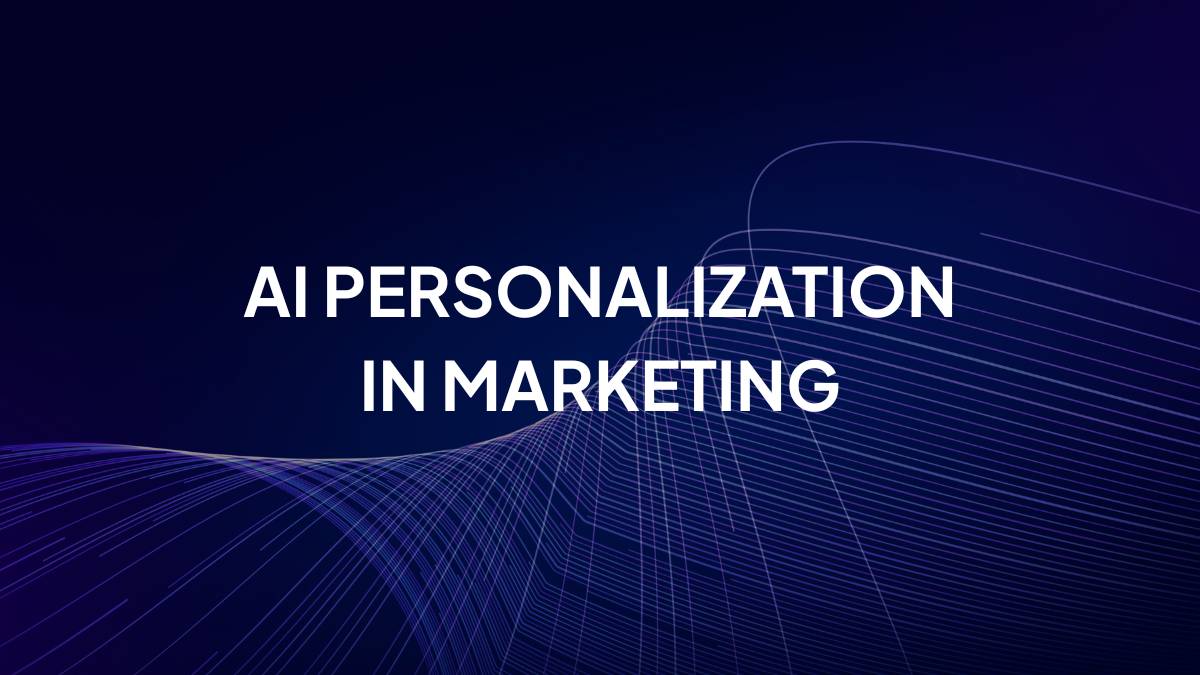Have you noticed how some brands just get you?
Like when Spotify recommends that one song you didn’t know you needed. Or when Netflix shows a movie that weirdly matches your mood. Or when you visit an online store and, boom, they’re showing you exactly what you were thinking about buying.
That’s not magic. That’s AI personalization in marketing working behind the scenes.
It’s basically the difference between shouting into a crowd and having a real conversation with someone. And in today’s world, where attention spans are fried and competition is everywhere, personalization isn’t just a “nice-to-have”, it’s survival.
So in this guide, I’m going to break down how AI personalization works, why it’s become the heart of modern marketing, where brands are using it, and what trends are shaping the future. No fluff, just practical stuff you can actually use.
Let’s jump in.
Table of Contents
Introduction: Why AI Personalization Matters in 2025
So… what exactly is AI personalization in marketing?
It’s basically using artificial intelligence to give your customers the feeling that your brand is talking just to them. It could be personalized product suggestions, customized emails, tailored ads, or even a homepage that changes depending on who’s visiting.
We’re not talking about “Hi [FIRST NAME]” anymore. That’s basic. This is deeper. It’s about predicting what someone wants before they even realize it.
Why is it becoming such a big deal right now?
Because we’re drowning in content. Every brand is fighting for attention. The ones that stand out are the ones that make people feel seen. AI makes that possible, even if you’ve got thousands (or millions) of customers.
It’s like scaling 1:1 conversations, without losing your mind trying to manually write hundreds of different emails or ads.
How are brands already using it?
- Amazon’s product recommendations? All AI.
- Spotify’s “Discover Weekly”? AI, every time.
- Netflix knowing you might love that obscure 80s action movie? You guessed it, AI again.
And it’s not just the big guys. Tons of smaller brands are using personalization to connect better, sell smarter, and build real relationships with their customers.
Major Benefits of AI Personalization in Marketing
If you’re wondering whether this stuff is actually worth your time, here’s why AI personalization is changing the game for marketers everywhere:
1. Higher Engagement Rates
People are more likely to click on something that feels relevant. Personalized subject lines get more opens. Personalized recommendations get more clicks. It’s simple, really, we like things that feel like they were meant for us.
2. Better Customer Experience
Nobody likes feeling like just another number on a list. The more personal your marketing feels, the better the whole experience is for the customer. And happy customers = loyal customers.
3. More Conversions (and Better ROI)
Let’s be real: marketing is supposed to help you sell. Personalized product recommendations boost conversions. Personalized emails boost sales. Personalized ads reduce wasted clicks. It’s just smarter marketing, full stop.
4. Saves Time and Effort for Marketers
AI isn’t here to steal your job, it’s here to take care of the boring bits. Instead of you manually segmenting your email list or rewriting ad copy 20 times, AI can help automate those things so you can focus on the bigger picture.
5. Builds Long-Term Loyalty
When people feel like your brand understands them, they stick around. It’s not just about one sale, it’s about building trust and long-term loyalty. And that’s where real growth happens.
Key Applications of AI Personalization in Marketing
Alright, let’s talk practical. Where exactly can you use AI personalization? Pretty much everywhere. Here’s how brands are using it right now:
1. Personalized Product & Service Recommendations
We’ve all seen it:
- “You might also like…”
- “Recommended for you…”
- “Others also bought…”
E-commerce sites (Amazon, Flipkart, Myntra) use this like crazy. But it’s not just shopping. Netflix recommends shows. Spotify curates playlists. Even food delivery apps suggest dishes you might love based on your past orders.
It’s smart, and it works.
2. AI-Powered Chatbots and Conversational AI
Those annoying chatbots from a few years ago? Forget those.
Now we’ve got AI chatbots that can actually help. They remember your past purchases, answer questions in real time, and recommend products or services based on your activity.
Tools like Drift, Intercom, and ManyChat are helping brands build real, helpful conversations with customers.
3. Intelligent & Dynamic Content Creation
Creating content is exhausting, but AI is changing the game here too.
Now you can use tools to help write personalized blog intros, landing page variations, or even Instagram captions based on audience data.
It’s not about replacing writers, it’s about making content smarter for different types of users.
4. Predictive Personalization & Forecasting
This is where things get a little spooky (but in the best way).
Predictive personalization basically means using someone’s past actions to guess what they’ll want next. Say someone buys hiking boots, you could recommend waterproof jackets before winter even hits. Feels smart, right?
It’s also a game-changer for sales funnels. With predictive lead scoring, your sales team doesn’t waste time chasing people who probably won’t buy. Instead, they focus on the leads most likely to convert. Less guesswork, more results.
5. Tailored Emails & Messaging
Ever added something to your cart, left the site, and then got an email reminding you? That’s AI at work, sending the right message at the right time.
But it doesn’t stop with emails. Brands are doing the same thing with personalized SMS and push notifications on apps. The trick is to make it feel friendly and helpful, not like spam. If it feels like a real human sent it, you’re doing it right.
6. Dynamic Website Experiences
Your website doesn’t need to show the exact same thing to everyone anymore.
With AI, you can change what people see based on where they’re coming from, what they’ve looked at before, or even what city they’re in.
Let’s say someone’s been browsing shoes on your site, next time they visit, your homepage could show them more shoes, not random stuff they don’t care about.
Tools like Dynamic Yield or Optimizely make this easy, even if you’re not super technical.
7. Ad Targeting and Dynamic Pricing
Ever notice how once you Google something, that thing follows you around the internet? Welcome to AI-powered ad targeting.
But it gets better (or scarier, depending on how you look at it). Some brands also use dynamic pricing, changing prices in real-time based on demand, timing, or even what device you’re browsing on.
Think about how Uber’s prices jump during rush hour. Same idea here.
Want to learn how to actually use these tools? Check out our AI Marketing Course, we go hands-on with the exact platforms brands use to personalize their marketing like pros.

Advanced Techniques: Hyper-Personalization & Omnichannel Approach
Alright, let’s turn up the heat.
What’s the difference between regular personalization and hyper-personalization?
Personalization is something like: “Hey [Name], here’s a product you might like.”
Hyper-personalization takes it way further:
“Hey [Name], based on that winter jacket you bought last week and the hiking gear you keep checking out, here’s a waterproof tent we think you’ll love. And by the way, looks like rain’s coming to your city this weekend.”
See the difference? It’s not just about names or what’s in someone’s cart. It’s about using real-time behavior and predictive insights to deliver something truly helpful.
But here’s the thing, it’s not about being creepy. It’s about making life easier for your customers.
Now, Omnichannel personalization makes sure that this personalized experience doesn’t stop at just one place. It connects across:
- Emails
- Websites
- Ads
- Even physical stores
So maybe they click a link in an email → see that product again on Instagram → then get free shipping at checkout on your website. That’s how the smartest brands are doing it right now.
Top Trends in AI Personalization (2025 & Beyond)
Marketing’s moving fast, and AI personalization is moving even faster. Here’s what’s already happening, and what’s just around the corner:
1. Generative AI for Personalized Content
AI isn’t just recommending anymore, it’s helping brands actually create content that’s tailored to you.
Tools like ChatGPT (yeah, like me), Jasper, and a bunch of others are already helping with:
- Personalized blog posts
- Targeted email content
- Customized ad copy
It’s like having a writing assistant who doesn’t need coffee breaks.
Also Read: Types of Generative AI Models
2. AI in AR/VR Shopping Experiences
This one’s super exciting. As virtual reality (VR) and augmented reality (AR) get bigger, AI is going to start personalizing those experiences.
Imagine trying on sneakers in AR, and the system suggests the perfect hoodie to go with them, because it knows what else you’ve browsed before.
Fashion, beauty, even home decor brands are already testing this.
Also Read: The Future of Digital Marketing
3. Emotion AI & Sentiment Targeting
AI’s getting better at reading between the lines, literally.
It can look at things like emails, chat messages, or social comments and pick up on whether someone’s happy, annoyed, or ready to buy. Then it can adjust how it responds.
Subtle, but powerful.
4. Voice & Visual Search Personalization
Voice search is becoming normal. “Hey Alexa, find me a waterproof backpack.” And you can bet AI will soon start making personalized suggestions based on what it knows about you.
Visual search is catching up too. Snap a pic of a cool jacket? AI will help you find the exact one or something similar, based on your style.
This is the next big shift for e-commerce.
Also Read: Voice Search Optimization
5. Privacy-First Personalization (Zero-Party Data)
As privacy concerns grow, brands are shifting to zero-party data, data that users willingly give, like style preferences, favorite colors, or product types.
It’s all about balancing personalization with respect for privacy.
Challenges of Using AI for Personalization
Of course, it’s not all sunshine and sales. Using AI for personalization comes with its own set of challenges. Let’s be honest about them:
1. Data Privacy & Compliance
With regulations like GDPR and CCPA, you can’t just collect whatever data you want. You need clear consent and transparent privacy policies. Otherwise, you’re risking fines and, worse, losing customer trust.
2. Data Quality & Fragmentation
Even if you have a ton of data, if it’s messy, incomplete, or spread across too many systems, AI won’t be able to personalize properly. Good personalization starts with clean data.
3. Complex Segmentation
It’s easy to overcomplicate audience segments and miss the mark entirely. The trick is to find that sweet spot where segments are detailed but not so narrow that they become useless.
4. Over-Personalization Risks
Ever get an ad that felt too personal? Yeah, that’s a thing. There’s a fine line between helpful and creepy. The key is subtlety and focusing on value over pushing a sale.
5. Technical Barriers for Smaller Teams
AI tools can feel intimidating, especially for small businesses. But honestly, start small. You don’t have to use every feature right away. Pick one channel, test it, learn, grow.
How to Get Started with AI Personalization in Marketing
If you’re ready to dive in, here’s how to actually start, no fluff, just steps:
- Set clear goals – Are you trying to boost sales? Improve engagement? Start with the outcome you want.
- Pick the right tools – Don’t get overwhelmed. Start with tools that fit your business size. Even email marketing tools like Mailchimp or Klaviyo have built-in AI features now.
- Clean up your data – Make sure your customer lists are up to date. Garbage in = garbage out.
- Start small – Maybe start with personalized product recommendations or behavior-triggered emails. Test, measure, adjust.
- Learn as you go – Upskill yourself or your team. Don’t just buy software, learn how to use it properly. (We cover this stuff step-by-step in our AI Marketing Course, if you want the shortcut.)
Conclusion
Look, marketing’s changed. People don’t want random emails or ads anymore, they want stuff that actually matters to them. That’s where AI personalization in marketing steps in.
It’s not about being creepy. It’s about being helpful. Showing people things they’ll actually like, making their experience better, and yeah, making more sales too.
And don’t think this is just for big companies with massive budgets. Even small businesses can start with simple personalization tools today. It’s way more doable than it used to be.
Start small. Learn as you go. Test things out. The brands that are going to win in the next few years? They’re the ones who actually listen to their customers.
FAQs: AI Personalization in Marketing
Q1. What’s the difference between personalization and hyper-personalization?
Personalization is basic, like using someone’s name. Hyper-personalization uses real-time data, like what they’re clicking or searching for, to recommend stuff they actually want next.
Q2. Can small businesses afford AI personalization?
100%. A lot of the best tools have free versions or start super cheap. You don’t have to go all-in on day one. Just test one thing, see how it works, and build from there.
Q3. How does AI help improve email marketing personalization?
AI looks at how people interact with your emails, like what they click or ignore, and helps you send better stuff at better times, with subject lines that catch their attention.
Q4. Does AI personalization compromise user privacy?
Only if you misuse it. If you’re honest about how you use data and follow privacy rules, you’re good. Always focus on helping people, not tricking them, and you’ll build trust.
Q5. Which AI tools are best for personalization?
Big names like Dynamic Yield and Optimizely are great if you’re ready for advanced stuff. Starting small? Tools like Mailchimp and Klaviyo are super beginner-friendly and have solid features.
Q6. How quickly can I see results from using AI personalization?
Honestly, you might see little wins in just a few weeks, like more clicks or sales. Bigger, long-term results usually come after a couple of months of testing, learning, and tweaking.

